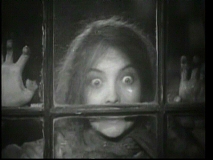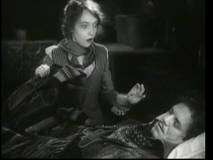|
Newest Reviews:
New Movies -
The Tunnel
V/H/S
The Tall Man
Mama Africa
Detention
Brake
Ted
Tomboy
Brownian Movement
Last Ride
[Rec]³: Genesis
Hara-Kiri: Death of a Samurai
Indie Game: The Movie
Abraham Lincoln: Vampire Hunter
Old Movies -
Touki Bouki: The Journey of the Hyena
Drums Along the Mohawk
The Chase
The Heiress
Show
People
The Strange Affair of Uncle Harry
Pitfall
Driftwood
Miracle Mile
The Great Flamarion
Dark Habits
Archives -
Recap: 2000,
2001, 2002,
2003, 2004
, 2005, 2006,
2007 , 2008
, 2009 ,
2010 , 2011 ,
2012
All reviews alphabetically
All reviews by star rating
All reviews by release year
Masterpieces
Screening Log
Links
FAQ
E-mail me
HOME
| |
The Wind (Victor Seastrom, 1928)
 Clearly one of the indisputable
achievements of the silent era, Victor Seastrom’s The
Wind is a melodrama of elemental force. As the film begins, the heroine
Letty (Lilian Gish) leaves her Virgina home, only to find life at the dust bowl
ranch she arrives at to be nightmarish. Not accustomed to the harsh, unmannered
life of the frontier, she is forced to pick between a trio of unsavory suitors
in order to escape it. Filmed on location in the Mojave desert, The Wind has remarkable environmental intensity. The film invokes nature in a way that renders human concern trivial, and amplifies the
threat of defeat. Seastrom achieves uncanny perfection in his deployment of
potent visual metaphors. The wind, which is the most obvious and oppressive of
these, is incorporated into the director’s visual palette in a stroke of
genius. Personified by a galloping steed, the wind incessantly rages in the
background. The chaotic motion of
swirling dust marks almost every frame, serving as a constant reminder of the
heroine’s fragile mental state. Gish, rather perfect here, looks appropriately
out of place in this world. The way she always seems to be waging a battle with
her hat in the earliest scenes segues perfectly into her subsequent interior
battles. Clearly one of the indisputable
achievements of the silent era, Victor Seastrom’s The
Wind is a melodrama of elemental force. As the film begins, the heroine
Letty (Lilian Gish) leaves her Virgina home, only to find life at the dust bowl
ranch she arrives at to be nightmarish. Not accustomed to the harsh, unmannered
life of the frontier, she is forced to pick between a trio of unsavory suitors
in order to escape it. Filmed on location in the Mojave desert, The Wind has remarkable environmental intensity. The film invokes nature in a way that renders human concern trivial, and amplifies the
threat of defeat. Seastrom achieves uncanny perfection in his deployment of
potent visual metaphors. The wind, which is the most obvious and oppressive of
these, is incorporated into the director’s visual palette in a stroke of
genius. Personified by a galloping steed, the wind incessantly rages in the
background. The chaotic motion of
swirling dust marks almost every frame, serving as a constant reminder of the
heroine’s fragile mental state. Gish, rather perfect here, looks appropriately
out of place in this world. The way she always seems to be waging a battle with
her hat in the earliest scenes segues perfectly into her subsequent interior
battles.
 Beyond its evocative environments, The Wind is also remarkable for its psychological exactitude. At any
given moment, we are privy to the inner workings of Letty’s mind. Even though
the extent of her mania makes her somewhat unsympathetic, the film never shies away from
detailing her motivation. Several exceptional moments, such as the one showing
Letty’s wedding night, are startling in their intimacy. The scene details the
newlyweds’ interplay primarily through close-ups of their feet, striking directly at the
physical fear of sexual relations that lies at the root of Letty’s attitude
toward her husband. Similarly, the scenes in which Letty is contrasted with the
jealous wife of her childhood friend are almost painfully direct. Letty is
dainty and unwilling to face her predicament, while her rival is literally shown
in situations where she’s butchering an animal and manning a carriage. There's
no mistaking where each of them stand. As the
melodrama escalates past this point, Letty finds herself in increasingly
impossible predicaments. Repulsed by her husband sexually, she needs him to
protect her from the lecherous Roddy. She clearly knows that Roddy is
dishonorable, but she needs his companionship when the alternative is being
alone with the sound of the wind, which always threatens to send her hurtling
toward madness. Though the ending of The Wind, which was changed from the
novel and was incidentally imposed upon the studio by the film exhibitors, is
out of step with what’s come before, it is hardly enough to disqualify
Seastrom’s film as bona fide masterpiece. Beyond its evocative environments, The Wind is also remarkable for its psychological exactitude. At any
given moment, we are privy to the inner workings of Letty’s mind. Even though
the extent of her mania makes her somewhat unsympathetic, the film never shies away from
detailing her motivation. Several exceptional moments, such as the one showing
Letty’s wedding night, are startling in their intimacy. The scene details the
newlyweds’ interplay primarily through close-ups of their feet, striking directly at the
physical fear of sexual relations that lies at the root of Letty’s attitude
toward her husband. Similarly, the scenes in which Letty is contrasted with the
jealous wife of her childhood friend are almost painfully direct. Letty is
dainty and unwilling to face her predicament, while her rival is literally shown
in situations where she’s butchering an animal and manning a carriage. There's
no mistaking where each of them stand. As the
melodrama escalates past this point, Letty finds herself in increasingly
impossible predicaments. Repulsed by her husband sexually, she needs him to
protect her from the lecherous Roddy. She clearly knows that Roddy is
dishonorable, but she needs his companionship when the alternative is being
alone with the sound of the wind, which always threatens to send her hurtling
toward madness. Though the ending of The Wind, which was changed from the
novel and was incidentally imposed upon the studio by the film exhibitors, is
out of step with what’s come before, it is hardly enough to disqualify
Seastrom’s film as bona fide masterpiece.
91
04-07-05
Jeremy Heilman
|